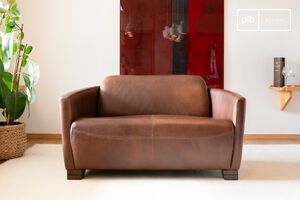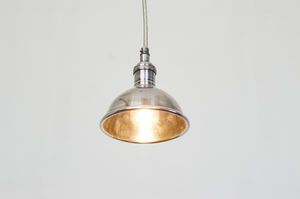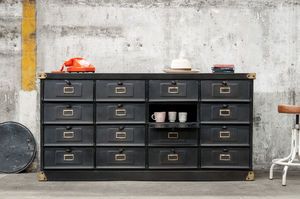assistant
French Days
10% off everything

INDUSTRIAL STYLE
Industrial style, also referred to as industrial chic, modern industrial, in interior design is an aesthetic trend that can be traced back to the middle of the 20th century, probably in New York City with the loft apartment movement in the 60s. The style has come back around the late 2000s and still very much in fashion since for a good reason.
Characteristics
Within the exposed brick walls with high ceilings and large windows, bared wooden beams, and metal installations, the open space is generous and airy for having everything in one place, a place to cook and place to eat, a place to sleep and a place to chill. It was very much different from other architectural and decoration styles at that time and still, its relaxed charm holds true up to date.
Its raw and honest nature is particularly attractive for those who wish to break out from the mass-produced modern trends, offering an off-grid approach that honours the history and value of the space, embracing it for what it is. The original functionality and efficiency of the once warehouses, factories and other industrial buildings are celebrated and accentuated with the use of wood and metal in furniture, lighting fixture and decoration of the similar style.

Metals like iron, copper, tins, steel, aluminum are a perfect match to the Industrial style.

Bare walls, metal installations and unpolished furniture give a strong character to a living space.
“In wagons and cars, metal has gradually eliminated wood. Should it be the same, one more or less distant day, in the household furniture? Will we see all-metal furniture...?”
Léon Déshairs, Art et Décoration, 1927
Origin and Development of Industrial Architecture
The first industrial spaces were built back in late 1700s during the first Industrial Revolutions with only one view in mind: efficiency and safety. They were meant to be simple, utilitarian and inexpensive to facilitate and streamline work and lower production cost. Bare brick wall offered no frills. Open floorplan with narrow interior structures economized space used per worker. Large windows allowed natural light flooding in to save lighting expenses. Heavy concerns on the safety of such condensed working environment from fires and explosions advocated by insurance companies also contributed to the flat roofs, austere facades, open space without any ornamental features that avoided the stairwells flanking in the buildings and any other obstructions during fire suppressions.
By the end of the second Industrial Revolution, in the early 1900s, new advancements in technologies as well as new way for producing energy like burning coals led to the new demand for an updated construction of industrial sites. Thanks to Albert Kahn, one of the most influential architects in industrial design, the plants benefited from the introduction of concrete and steel.

Original finitions that showcase signs of time are respected and appreciated.
In this universe
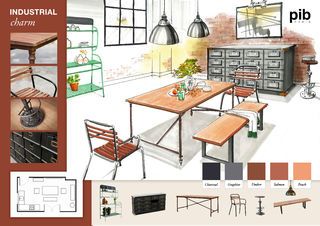
In the 20s - 30s, thanks to modern production methods, metal furniture took hold in the urban landscape.
Indutrial charm of the 20s - 30s - Styling board
INDUSTRIAL STYLE - 04-Aug-2021
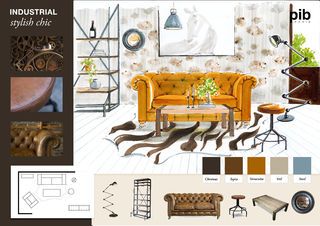
Create a stylish and elegant living room with the robust industrial style adapted after World War II
Industrial Chic after WWII - Styling board
INDUSTRIAL STYLE - 08-Oct-2021
Associated Products
Elements of Style
All the architectural evolutions resulted in the ?unfinished? look of bare concrete flooring, exposed bricks, visible ductworks and iron pipes have finally become the iconic characters of the style that are now well-loved and prized.
- Open layout with spaces created by the placement of furniture
- Exposed structural and mechanical elements: exposed piping, ventilator tubes, support beams, and poles, and wood or concrete floors
- Large, simple windows (often floor-to-ceiling) to maximize the natural light
- Metal, wood, and natural materials: tins, irons, steels, aluminum, coppers, stones, woods, leather
- Neutral palette of colours: blacks, greys, whites, browns, and tans
- Square, angular, blocky furniture with a few bold statement pieces and limited accessories
- Large sectional items: essentials to divide, define spaces, and ensure the natural flows
Industrial style furniture
Industrial style furniture was named after its original purpose, to support the functionality and mass production of the manufacturing industry. Dated back as early as 1760 in Britain, its style was designed to be simple, economical, practical, easy to produce, use and maintain, and made to withstand harsh conditions in laborious working environments. It was merely part of daily work. Yet today, it is well appreciated for the same rustic and raw qualities. The main characteristics of Industrial Style furniture are:
- Functions and form well married, old and new, ?high and low? elements combined
- Reclaimed or is fashioned after old factory-style furniture
- Raw materials with a distressed paint or unpolished surface for an unfinished feel
- Craftsmanship honoured
- Environmentally friendly approach as it encourages the use of recycled or salvaged materials
Evolution of Style
- End of the 19th - Beginning of the 20th century - exclusive use in large factories
- The 20s - 30s of the 20th century - installation in the urban landscape
- After the WWII - invitation to the home
- High Tech - contemporary detours and reinventions
End of the 19th - Beginning of the 20th century - exclusive use in large factoriess
Industrial furniture from the 19th century is exclusively devoted to the use of factories. The materials are robust and massif and the design is simple and functional. Wood and metal are the main materials that are used in the industrial style. During this industrial revolution, a decorative movement found the place with the motto: maintenance and adaptability.
The 20s - 30s of the 20th century - installation in the urban landscape
The democratization and the first use of industrial style furniture start in the period of the post-war era. That was possible because of the manufactories and the adaption of the personal and domestic use of furniture in metal. Until that period housewives preferred furniture made out of wood. Since the change of metal furniture was quite great, at the very beginning people would put wood on seating surfaces and backrests of their furniture. This made the contrast to the metal furniture a little less strong and made it easier for people to adapt to that different style of furniture.
After the WWII - invitation to the home
The democratization and the first use of industrial-style furniture start in the period of the post-war era. That was possible because of the manufactories and the adaption of the personal and domestic use of furniture in metal. Until that period housewives preferred furniture made out of wood. Since the change of metal furniture was quite great, at the very beginning people would put wood on seating surfaces and backrests of their furniture. This made the contrast to the metal furniture a little less strong and made it easier for people to adapt to that different style of furniture.
High Tech - contemporary detours and reinventions
The trend of industrial high-tech deco style overflows the New York lofts of the 80s. This style spreads massively through the new use of old workshop furniture. Because of the flourishing of the 'high tech deco' contemporary furniture adapts the characteristics of the industrial style. For example, cast iron, riveted sheet metal, and patina. Furthermore, industrial furniture is used with a modern finish, and colour is often added, this makes a difference to the original industrial furniture.
Comparison with other styles
Industrial style articles are often reclaimed, recycled, and reused, many of them are veteran pieces. But unlike Shabby Chic where vintage articles are elaborated with floral motifs and patterns, with curves and rounded angles, with softness and femininity, the industrial style exudes a utilitarian, fuss-free vibe with straight lines and clearly angular shapes. Nothing should be shouting for attention, over the top, or extravagant.
At this, the style should also be distinguished from minimalism. Though sharing several principles like concentrating on quality over quantity, a minimum number of accessories, industrial style can employ a minimal approach but its end does not always result in a restrained, austere simplicity. It can play a lot on textures and materials without going prodigal nor sacrificing warmth and comfort.

